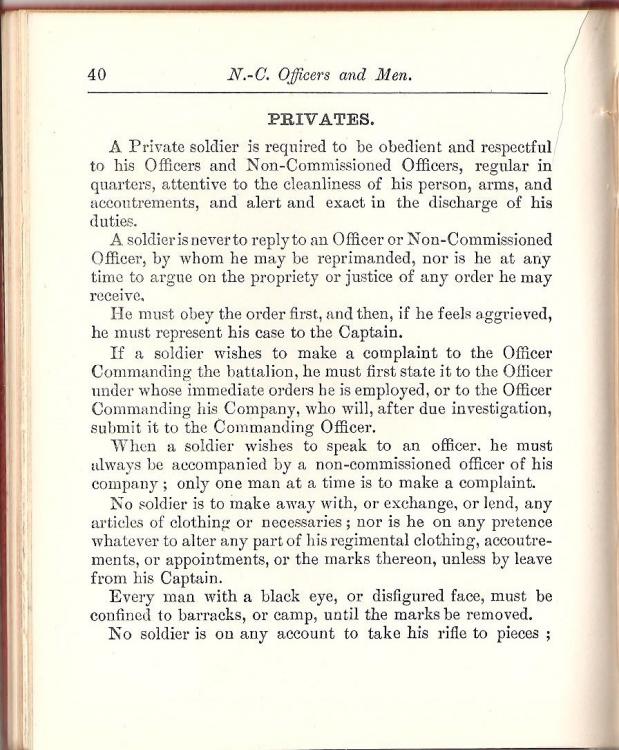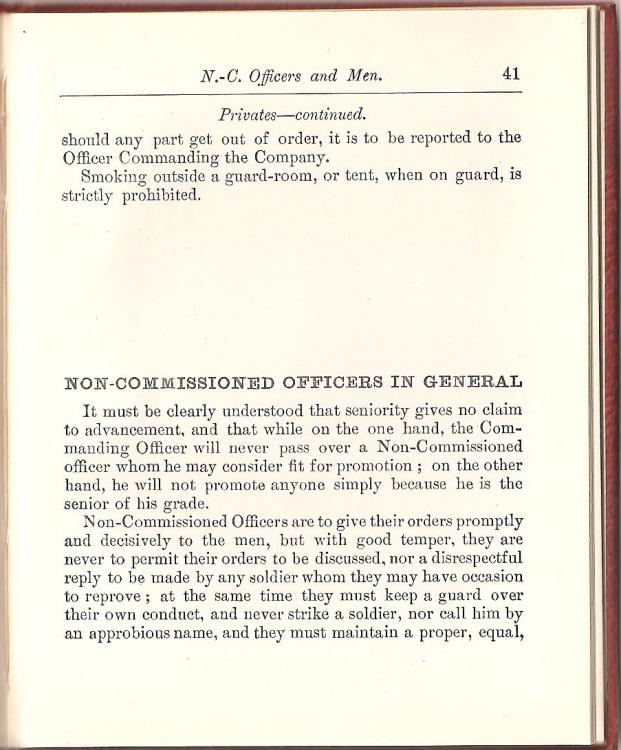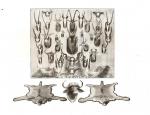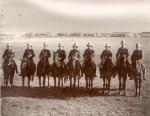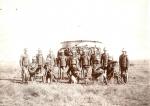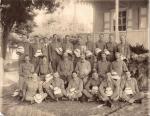-
Posts
1,065 -
Joined
-
Last visited
-
Days Won
1
Content Type
Profiles
Forums
Blogs
Gallery
Events
Store
Everything posted by Graham Stewart
-
A quick read through them, gives you a detailed aspect of how the Battalion was run and how both Officers and N.C.O.'s should behave within the Battalion. This one, in particular, regarding the Privates caught my eye and made me laugh, a line towards the end makes interesting reading regarding "appearance". Have any you ex-service types ever been confined to barracks after a NAFFI queue punch-up?
-
Printed in Alnwick the H.Q. of the 3rd Bn, this particular copy also has the inclusion of the name of the officer to whom they belonged and in this case possibly a distant relative to a well known actress - "Helen Bonham-Carter". The name of the officer being 2nd Lieut Ian Malcolm Bonham-Carter(later Air Commodore, R.A.F. - http://en.wikipedia.org/wiki/Ian_Bonham-Carter), who was initially commissioned into the *5th(Militia) Bn on the 2nd November 1900, before receiving a 'regular' commission on the 4th December 1901. *Note - During the expansion of the Army in 1900, two additional Regular Battalions were added to the Northumberland Fusiliers named the 3rd & 4th Bn's. The 3rd(Militia)Bn was then re-titled the 5th(Militia)Bn.
-
Gentlemen - not been around for a while, but have just come into possession of what must be one of the rarest copies of "Standing Orders" to the N.F. that I've ever come across and they are to the 3rd(Militia)Bn, dated 1st July 1896. I have numerous copies relating to the Regular Battalions, but in all my years collecting have never seen a copy associated purely to the 3rd Bn and so just had to bring them to the attention of our GMIC members.
-
This pattern was first introduced in 1881, when the coloured facings of 'non-Royal' infantry regiments were changed to 'white' and 'Royal' regiments adopted dark blue. Exceptions being non-Royal Irish Regiments who adopted 'green' facings and non-Royal Scots who adopted 'yellow'. By 1900 old facings colours were being re-adopted, but believe the Lancashire Fusiliers continued to wear the new white facings in preference to their old 'yellow' facings up until 1914. It's interesting to note that the collar badges on your uniform are the plain gold bullion grenades, but have no metal centre device on the ball of the grenade which would identify them as Lancashire Fusiliers. I collect to the Northumberland Fusiliers and my uniform collection can be found here;- http://gmic.co.uk/index.php/topic/25563-the-royal-northumberland-fusiliers-moderators-choice/page-14
-
Been a long time since I was last here on GMIC, mainlly because nothing of interest has cropped up regarding the N.F., until the above appeared on a certian well known auction site. A well posed period photo of a Sgt in blues, pipe in mouth and a paper journal in his hands, taken "somewhere", but no photographers name on the reverse. However in the bottom right hand corner is the simple hand written message - "Yours truly, G. Pullan, 5th Fusiliers". In this day of online research at your finger tips from many family history sources, one would have thought he was easy to research and a price to match would be added. However there are currently no records of a G. Pullan to be found on the internet and so it was bought for under a tenner. As an avid researcher of the Northumberlands since leaving the R.N. in 1981, I have amassed, possibly, one of the largest 'regimental' databases in the world, containing the details of over 90,000 inidividuals who served during the Great War alone. It's from that database that I can actually tell you that we're looking at;- 6162 Sgt Granville Pullan of Leeds, West Yorks, who enlisted into the Northumberland Fusiliers in late 1899. On completion of his training he was posted to 'C' Company, 3rd Bn, N.F.. He was probably of above average intelligence, suggesting a good education, because on the 25th May 1900, he was appointed acting-Lance Corporal, attaining the 3rd Best Shot in the Battalion in the June. Promotion for Granville came rather rapidly and on the 1st August 1900, he became Lance Corporal and on the 23rd November 1900 was promoted Corporal and was posted to 'A' Company. With the ending of the South African War the 3rd Bn, N.F. was disbanded in 1907, but it appears that Granville had opted to continue to serve with the N.F. and complete his Army career with them, because he is then posted to the 1st Bn, N.F., where we find him as a Sgt, being promoted to Colour Sgt on the 5th November 1912. He is still with the 1st Bn on the outbreak of War in August 1914, probably going to France with the Battalion on the 14th August. Not a lot is known of his 'War' and he may have been posted to other Battalions, although nothing is mentioned in the Medal Rolls. I then find him being appointed Quarter Master Sgt on the 21st May 1915. Continuing to serve he is awarded the Distinguished Conduct Medal on the 17th April 1917, which prompts a further appointment to acting-R.S.M. in the May. He eventually becomes Regimental Sergeant Major, a well deserved promotion, which warrants a Mention in Despatches on the 20th December 1918. His career didn't end with the cessation of hostilities, rejoining the 1st Bn in July 1919, and he was still serving in February 1920, having been renumbered 4256011 and at that point the trail goes cold. A single 'uninteresting' portrait photograph of a Sgt in blues it may be, but Granville Pullan has a pride of place in my collection.
-
"First, prior to 1920 each regiment had its own system of regimental numbers (each starting at 1). If a soldier transferred to another regiment he got a new number." Not 100% true and typical of those who know little of the numbering system, which was brought into use around 1880. Each Regiment did indeed start at number 1, but the numbers only went up to 9,999 and once used up they had to start again at 1, but numbers which were already in use by serving soldiers couldn't be re-issued, as this would cause duplication. In 1906 an extra 10,000 was added to the system, so that units could now number from 1 to 19,999 and not many regiments had reached this figure by the time of the outbreak of the Great War, but rather than go back to number 1 on reaching the ceiling figure they just carried on. Now to the parts totally unknown by ARSSE - The Militia had its own numbering system, which also began at number 1, but it also finished at 9,999 with no change in 1906, but to identify them specifically as Militia, the number was often pre-fixed - normally with a '3/'. In 1908 things became a bit more complicated when they became the Special Reserve, but the vast majority of them continued numbering numerically, with a few reverting back to number 1 and keeping the pre-fix Battalion number. During WWI they too carried on numbering beyond 9,999. Each Volunteer Battalions within a Regiment had its own numbering system, again starting at 1 and finishing at 9,999, with no change in 1904. However in April 1908 when they became Territorials they virtually all restarted numbering at number 1. In 1915 it was all change with the pre-fixing of these numbers with the Battalion numeral, e.g. for the Northumberland Battalions you would get 4/1234; 5/1234; 6/1234 & 7/1234; This continued satifactorily until 1917, when numbers began running out and then they adopted a six figure system and the pre-fix was dropped. At one time the Northumberlands had six men all using the same number, but from various Battalions and this was seen throughout the Army. Good pamphlet to read on Numbering;- "Regimental & Army Numbers of the British Line Infantry Soldier from 1800 to 2008" by David Langley & Graham Stewart.
-
Sorry for my late appearance with this one, but sometimes a name can be found under the brown leather sweatband - take a peak, and if there is we'll try and give you some background. My only concern is the badge which appears to be an other ranks capbadge and not the officers silver & gilt or am I wrong. Illustrated is my own officers cap from my collection.
-

WWI Officers group photo
Graham Stewart replied to Markgraf's topic in Great Britain: Research, Documentation & History
Both Officers and OR's of the Labour Corps wore the G.S. cap badge from the formation of the Corps as stated in Army Council Instruction 611, Para 17 of the 13th April 1917, The Labour Corps badge, which we are more familiar with, didn't make it's appearance until the end of the War. -
Among the more unusual photo's was this one, as it would appear that 'Choppie' Leslie, became a well known hunter and writer of a series of articles, which appeared in St.Georges Gazette, the Regimental Journal of the Northumberland Fusiliers. The main title heading of the article was "Big Game Hunting in Barotseland", which appeared in the journal in July 1910, which were completed in May 1911. No matter what our thoughts are today on 'big game hunting', during this period of time it was an expected part of an officers life when based in the Colonies. However 'Choppie' didn't just hunt but he actively studied the numerous native tribes which were scattered throughout Southern Africa at the time, and his articles were often accompanied with photographs of native Africans in their traditional clothing. His final article finished with the following poem;- "To sit on rocks, to muse o'er flood and fell, To slow trace the forests shady scene Where things that own not mans dominion dwell, And mortal foot hath ne'er, or rarely been; To climb the trackless mountain all unseen, With the wild flock that never needs a fold; Alone o'er steeps and foaming falls to lean; This is not solitude; tis but to hold Converse with Natures charms, and see her stores unroll'd. But midst the crowd, the hum, the shock of men, To hear, to see, to feel, and to possess, And roam along, the worlds tired denizen With none who bless us, none whom we can bless; Minions of splendour shrinking from distress! None that with kindred consciousness endued, If we were not, would seem to smile the less Of all that flattered, followed, sought and sued; This is to be alone; this, this is solitude!" Choppie Leslie continued to serve with the 2nd Battalion, Northumberland Fusiliers and eventually became the O.C. of it's Mounted Infantry Section, being promoted to Captain on the 18th February 1911. With his skilled horsemanship Choppie Leslie eventually transferred to the 3rd Dragoon Guards, prior to the outbreak of the World War One. He was badly injured in the opening actions of the conflict, including the loss of an eye, and upon his return to duty was seconded to the Seine Divisional H.Q. for the duration of the War. He was later awarded the Military Cross, and then given the honorary rank of Brevet-Major. However, having never regained full health, he died at Corravahan in August 1919. Among all of these photo's were the sad reminders of his death, which are a series of condolence letters to his family from fellow officers with whom he had served. R.I.P. Captain Cecil George Leslie - Quo Fata Vocant.
-
Among Choppies photo's was this very large one of the officers of the 6th Bn, Mounted Infantry on the veranda of an unknown house somewhere in South Africa, which probably substituted as the Officers Mess. The photo itself is a prime example of an Edwardian Officer group and the detail in such photographs are superb and it's a pleasure to own such items. Choppie himself is stood on the veranda, behind the officer who is wearing the bandolier.
-
The Company mounted as a whole, when compared to the same number of mounted men on the same day in 1903. The 3rd Bn, including the M.I. Coy, embarked for Southampton on the 8th February 1907, on the "Braemar Castle" arriving on the 3rd March. From Southampton it moved to Badajoz Barracks, Aldershot, where all but the "time expired", were transferred to the 2nd Bn, Northumberland Fusiliers and the 3rd Bn, Northumberland Fusiliers ceased to exist. Officers were then given two months leave.
-
St.Georges Day 1905 at Tempe Barracks, Bloemfontein, Orange River Colony and "No.2(N.F.)Coy, 6th Battalion, Mounted Infantry" in all their glory. "Choppie" is seated to the far right of the offiers as we look at them. What is interesting is the size of the Company which appears to have grown since arriving in South Africa. The C.O. of the Company, Captain & Brevet Major B.T. Buckley, N.F., can be seen in the centre of the officers.
-
The next two officer group's of the 6th Bn, M.I., have an uncertain timeline to them, but once again 'Choppie' can be clearly seen. In this photo he's standing rear centre, with his F.S.H. tucked into the right of his body. In this photo officers of the Middlesex Regt can easily be identified by their collar badges and possibly the officers with 'red' tabs to their collars may actually be Ox & Bucks Light Infantry, suggesting that there were changes to the make up of the 6th M.I. as time went on.
-
During it's time in South Africa the 3rd Battalions M.I.C., was assigned the the 6th Battalion, Mounted Infantry, as it's No.2 Company. Here is a photograph of the officers of the 6th Mounted Infantry, which also consisted of Mounted Infantry Company's from the Cameron Highlanders, Manchester Regt and Duke of Cornwalls Light Infantry. "Choppie" Leslie is the officer standing to our far left of the group, easily identified as an officer of the N.F., by the additional scarlet cloth in the khaki pagri of the F.S.H.. For the more keen eyed among you, you make actually see the head dress badge of the '6th M.I.", being worn in the centre of the F.S.H., which consists solely of a '6' above the letters 'MI' in brass.
-
In July 1902 the Battalion set sail once again and left Antigua aboard the S.S. "Roslin Castle" finally arriving in Cape Town on the 27th August 1902, arriving at Wynberg Camp, where they accommodated in some empty huts. It was from there that the service of the Battalion began. In the attached we a small group of soldiers of the 3rd Battalion, N.F., complete with two Maxim Machine Guns taken "St.Georges Day" 1903(?) and the young officer in the front of the group appears to be Lieut C.G.Leslie, with a couple of pet dogs, who I presume would also act as guard dogs when the men were cooped up for the evening in the Sangar at the rear. This Sangar in the back ground was one of many hundreds that were stretched across the South African veldt, with the accompanying barbed wire in order to restrict the movements of the 'Boer Commando's'.
-
Prior to serving in South Africa the 3rd Battalion, Northumberland Fusiliers moved several times - from Victoria Barracks, Portsmouth to Fulford Barracks, York around March 1900. In May 1900 the Battalion moved to Strensall Camp, York and then onto the Barracks, Bradford in October the same year. In April 1901 the Battalion moved to the Parkhurst Barracks, Isle of Wight. There the Battalion remained until May 1902, when it embarked upon the S.S. "Atrato" and sailed for St.Michael in the Azores, eventually reaching the Camp, Antigua in June 1902, where I believe the above photo was taken.
-
A short time ago I managed to secure a large amount of photographs from a well known auction site. Nearly all of those items related to the above officer - Cecil George Leslie (nicknamed - 'Choppie' Leslie), who was born in 1879 at Corravahan House, County Cavan, Ireland. On the outbreak of the South African War, he took a commission in the Army and on the 5th January 1901, he became 2nd/Lieutenant C.G. Leslie, 3rd Bn, Northumberland Fusiliers, which was one of two additional 'Regular' Battalions assigned to the Regiment, which had been formed at Victoria Barracks, Portsmouth in 1900. Just over a year later, on the 12th February 1902, he was promoted to full 'Lieutenant', as seen in the above photo, wearing the double breasted officers frock coat. He appears to have been an accomplished 'horseman', as he went onto serve with the 3rd Battalions, Mounted Infantry Company, which during this period of time were regarded as 'elite' troops. As such nearly all of the following photo's concern C.G.L.'s time in South Africa from around 1903.
-

WWI Officers group photo
Graham Stewart replied to Markgraf's topic in Great Britain: Research, Documentation & History
Not General Service Corps I'm afraid, which was a Second World War formation, nor are they officers of the General List - they are infact officers of the Labour Corps. The officer to our far right appears to be wearing a G.S. cap badge, but it isn't and so I wonder if he's Manchesters. Again the one described as the Bucks Battalion, is a bit baffling, as I can find no reference of them wearing collar badges.



